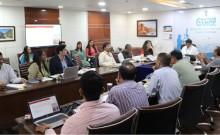
NASA led a successful mission to Mars with the robotic explorer Curiosity landing on the red planet at approximately 1.30 a.m. EDT on Monday.
Curiosity's gentle landing was aided by nylon cords that slowly lowered the rover to the ground, after which the connecting cords were disconnected. "The time of day at the landing site is mid-afternoon -- about 3 p.m. local Mars time at Gale Crater. The time at JPL's mission control is about 10:31 p.m. Aug. 5 PDT (early morning EDT)," the space agency said.
NASA connected a video camera to the spacecraft that would provide the first glimpse of contact with the planet. Dusty images of the historic touchdown were also beamed across the world, the first picture showing the rover's wheel and its shadow against the crater.
Shorty before the touchdown, NASA engineers waited with bated breath for what was described as "seven minutes of terror" while Curiosity made its way to the Martian atmosphere with speeds advancing 13,000 mph.
Curiosity's touchdown on Mars was accomplished after travelling 352 million miles in a 36 week journey from the Kennedy Space Centre in Florida's Cape Canaveral. This is NASA's seventh and possibly the most ambitious attempt to land a vehicle on the planet. Other attempts include the Opportunity rover which has been operating since 2004. The Spirit, a twin of the Opportunity, crashed out in 2009.
"It's an enormous step forward in planetary exploration. Nobody has ever done anything like this," John Holdren, the top science advisor to President Barack Obama, said about Curiosity's landing. "It was an incredible performance."
Following its successful landing, Curiosity will begin a two-year extraterrestrial feat over Mars' surface, collecting data on the planet's environment as part of NASA's quest to uncover evidence on the formation of primitive life in Mars' past.
The $2.5 billion project, also known as Mars Science Laboratory, carries on board 10 science instruments with a total mass 15 times as large as the science payloads on the Mars rovers Spirit and Opportunity. Some of the tools are the first of their kind on Mars, such as a laser-firing instrument for checking elemental composition of rocks from a distance, the space agency said.

















